#Das polychrome Ornament
Photo
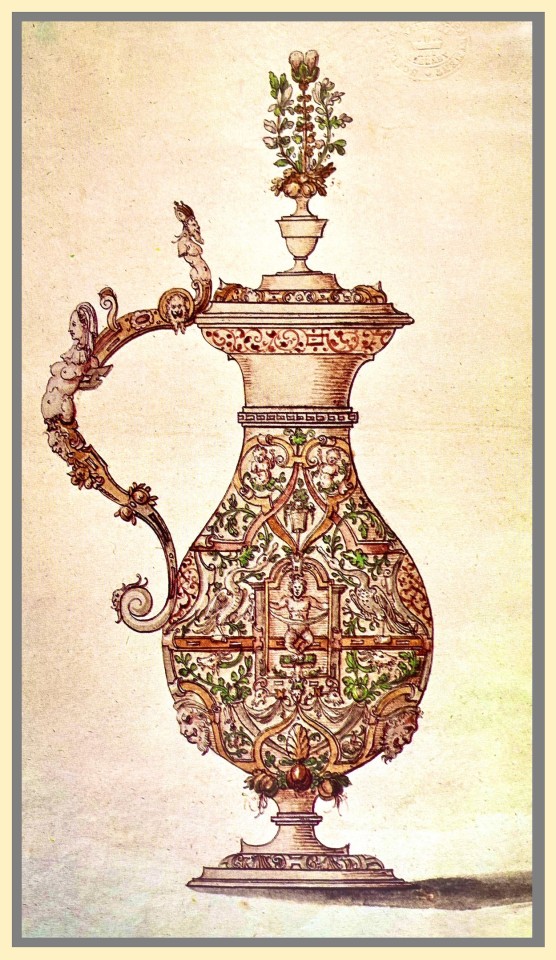

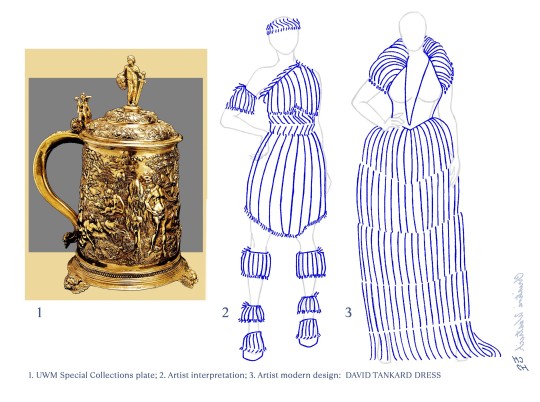

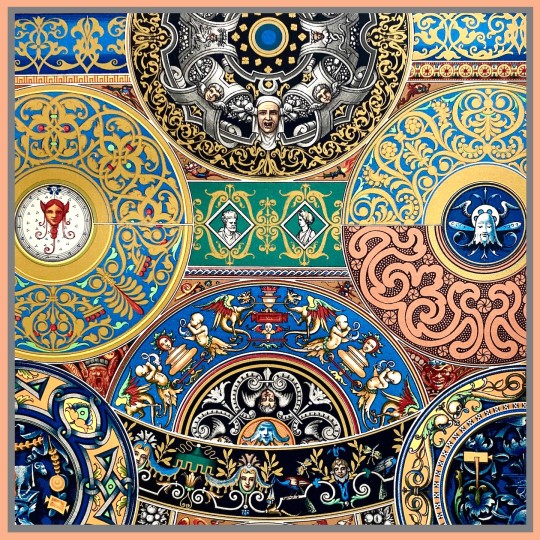


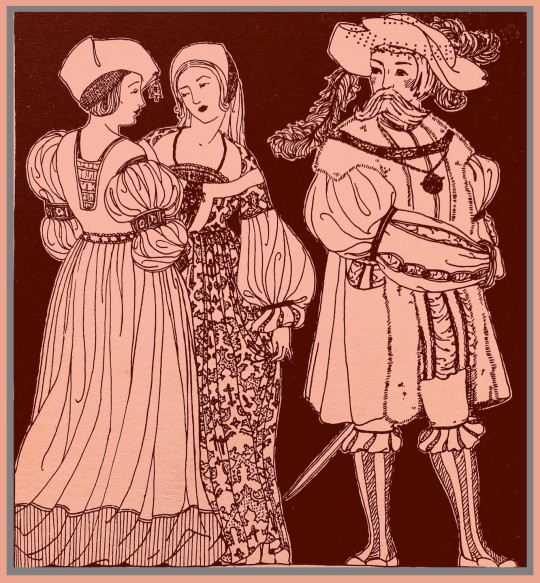

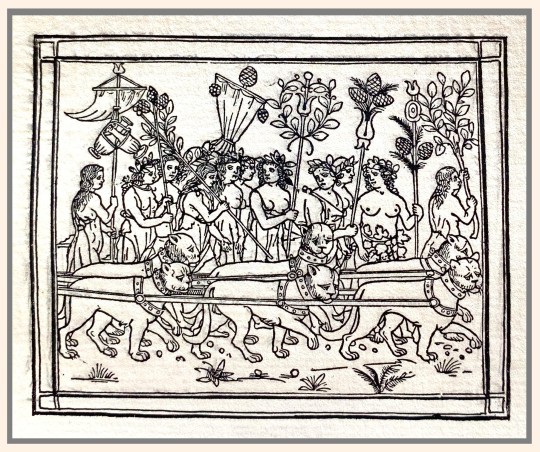
Fashion Friday: The Mannerism of Michelangelo
The Renaissance period is often synonymous with the greats of Michelangelo, Da Vinci, and young Raphael. These master painters poised "imitation" as preeminent beauty, art as poetry—ut pictura poesis—with Michelangelo arguably harnessing the peculiarities of the human spirit most adeptly in his abstract sprawl of figures, elongating their unseen beauty.
A Renaissance essay on Michelangelo by the nineteenth century art critic Walter Horatio Pater investigates the imagination of the master, calling attention to the artist's wayward loves-at-first-sight and their contradictions with the sculptor's mantra of la dove io t'amai prima, or, where I loved you before. Pater argues that it is precisely this paradox that comprises harmony: the delight between the sweet and the strange.
Pater repudiated his own time of the Victorian era, acclaiming the decadence of the Renaissance period as the seizing of life, or more aptly in his own words on living:
...to grasp at any exquisite passion... or any stirring of the senses, strange dyes, strange colours, and curious odours, or the work of the artist's hands, or the face one's friend.
It is in his words that we can embrace the unnatural grace of the late Renaissance, the period adorned with the Mannerist style of bold outlines, objects at-play with nature, and form with fantastical animal-humans. This unique style of the Renaissance is attributed to Michelangelo's successors who desperately tried to imitate his alien elegance.
Hidden in the figures of Michelangelo are these languid features, satyrs in repose, where solemnity and "faces charged with dreams" dictate, as described by Pater. Darting poetic thoughts give us a glimpse of the bittersweet temperament of Michelangelo's genius. He wrote of his torments in the pagan frivolities of endless quarrelling and his anger at the Gods for loving him so that he reached an age of eighty-eight years.
In all of his years, Michelangelo claimed his figures to be common, austere persons, yet his hand rendered an inherent surprise and energy that future imitators would exploit in quirky forest gods and lovely monsters.
Ergo, my first fashion plate is titled "DRAGON EWER Dress," odd, but not as eccentric as the last two designs; perhaps you can trace the growth of the outlandish creature in each iteration.
Here is a listing of sources from the UWM Special Collections which I have augmented with digital color and outline to emphasize particular details of my inspiration:
1) A watercolor drawing by (or after) Wenzel Jamnitzer, circa 1575 in the Virtuoso Goldsmiths and the Triumph of Mannerism, published by Rizzoli International in 1976.
2-4) My interpretation and contemporary design of the DRAGON EWER Dress, SNAIL CUP Dress and DAVID TANKARD Dress based on Renaissance period vessels between 1540 to 1590 as published in the Virtuoso Goldsmiths and the Triumph of Mannerism, published by Rizzoli International, in 1976.
5, 6) French Renaissance plates of frieze borders in Rouen prayer books from 1508; and painted enamel work of Limoges under Italian faience between 1520 and 1540 as published in the Das polychrome Ornament: Hundert Tafeln, by P. Neff in 1880.
7) Walter Pater included an image of Michelangelo's The Holy Family, or, Doni Madonna, at the Uffizi in Florence, Italy in his aethesticism manifesto, The Renaissance: Studies in Art and Poetry, published by the Limited Editions Club, Stamperia Valdonega in 1976.
8) Costume of the early sixteenth century often in velvets (red is common) and embellished with fewels, gold, lace, fur and feathers as illustrated by Belle Northrup in A Short Description of Historic Fashion published by the Teachers College at in 1925.
9) An 1592 engraving by Joseph Boillot titled Et Levrs Antipatie (possible translation Antipathy Lips) as published The Renaissance in France: Illustrated Books from the Department of Printing and Graphic Arts, by the Houghton Library, Harvard University in 1995.
10) A drawing or possible woodcut of indentured lions as published in Thomas Wood Stevens' Book of Words: A Pageant of the Italian Renaissance, published by the Alderbrink Press at the Art Institute Chicago in 1909 for the Antiquarian Society.
View my other posts on historical fashion research in Special Collections.
View more Fashion posts.
—Christine Westrich, MFA Graduate Student in Intermedia Arts
#Fashion Friday#graduate research#Christine Westrich#Renaissance#Renaissance fashion#fashion#costumes#costume design#fashion design#fashion plates#Michelangelo#Walter Horatio Pater#Virtuoso Goldsmiths and the Triumph of Mannerism#Das polychrome Ornament#The Renaissance: Studies in Art and Poetry#A Short Description of Historic Fashion#The Renaissance in France#Book of words; a pageant of the Italian renaissance
92 notes
·
View notes
Link
Florence is famous for being one of the most cultural and historical cities in the world and has many important architecture and places.
As the capital of Italy's Tuscany region, Florence has a population of 383,000 and an urban population of more than 1.5 million. This wonderful city is located in the central region of Italy and has a well-developed railway network with connections to Pisa and Bologna. In ancient history, Florence was once a Roman city and later developed into a thriving medieval commune. It is hailed as the birthplace of the Renaissance movement, and throughout the 12th, 15th and 16th centuries were one of the most important cities of the world. Notable residents of Florence include Machiavelli, Lorenzo Medici, Dante, Michelangelo, Donatello, Galileo, and Raphael.
[toc]
1. Florence Cathedral
Possibly the most celebrated cathedral in the world, the Duomo as it is simply known in Florence is the jewel of the city. It was initially constructed in 1436, but the astonishing front facade wasn’t completed until the 19th century.
Located in the center of the old city, the Duomo stands out for miles and creates an imposing sight amongst the other medieval buildings. The exterior and front facade of the Cathedral are monumental – covered in white marble and red, pink and green polychrome designs; the color and style are breathtaking.
Furthermore, an immense dome sits at the read of the cathedral and can be accessed via a series of steps.
Although the interior of the cathedral is quite bare in contrast, it still speaks of grandeur and has several interesting pieces such as the large clock face and the magnificent Last Judgement fresco that covers the underside of the dome.
2. Giotto’s Campanile
Many people believe that Giotto’s Campanile is connected to the Duomo however it is a separate building in its own right. This structure is a true masterpiece of Gothic architecture and is one of the most renowned designs in the city.
Split into five distinct levels, the exterior of the tower features polychrome marble decoration that is also present on the Duomo in brilliant green and pink colors.
Constructed in 1334 through to 1359, the building was designed by the famous artist Giotto but finished by Talenti who added the last levels after Giotto died 1343. A plethora of sculptures, artwork and decorated panels cover the tower and it is a true masterpiece of Renaissance art.
Aside from the decoration, you can also climb the 414 steps in the tower for fantastic views of Florence and the Duomo.
3. Palazzo Vecchio
Whilst the Duomo is the most important religious building, the Palazzo Vecchio is the most important administrative building in Florence. This structure stood as the palace of the Signoria of the Republic of Florence and was also a town hall in later years.
Originally built in 1299, the Palazzo was designed by the same architects that worked on the Duomo and the church of Santa Croce. With a square design and a number of crenulations, the building almost looks like a castle; it also has a large bell tower.
On the front facade, a series of the coast of arms can be seen that represent various families and important individuals relating to the history of the city. The interior of the palace is also sublime with a series of originally decorated rooms such as The Hercules Room and The Room of Cybele.
4. Ponte Vecchio
Florence is full of famous buildings and Ponte Vecchio is an extremely famous and old bridge.
Spanning the river Arno, the Vecchio Bridge is noted for the number of shops that are built into the sides of the bridge, its decorated history and the plethora of shops that line the main walkway.
History records date the bridge as early as 996 but its true origin is unclear. Walk onto this fantastic structure and look at the various shops and vendors – You will find jewelers, art dealers, and souvenir shops.
Once at the midpoint, the bridge opens up and you are rewarded with fantastic views down the River Arno. Aside from walking on the bridge itself also walk along the Corridoio Vasariano to see the exterior of the Ponte Vecchio and its marvelous house-like attachments.
5. Basilica of Santa Croce
Whilst the Cathedral of Florence boasts immense size, the Basilica of Santa Croce is truly beautiful and inviting. Constructed at a similar time to the Duomo, it also features a front facade that includes pink, green and red marble polychrome panels contrasted with polished white stone.
Sitting in the Piazza di Santa Croce, the Basilica takes a central position and frames the square perfectly.
Aside from the beautiful exterior, the interior is home to the tombs of some of the most influential Renaissance artists and scholars in the world including Galileo, Michelangelo, and Machiavelli.
6. Baptistery of St. John
Completing the trio of buildings associated with the Cathedral of Florence, the Baptistery sits in front of the main facade of the Duomo and is a completely separate building.
As one of the oldest buildings in the city, the Baptistery has been revered and its exterior features the wonderful “Florentine” design that is similar to both the Duomo and Giotto’s Campanile.
The three sets of bronze doors are of particular interest and depict various religious scenes and human virtues. Inside the Baptistery, a stunning golden Byzantine-style fresco covers the ceiling and upper walls and depicts the last judgment and other stories from the Bible and Genesis.
7. Uffizi Palace and Gallery
Located just off of the Piazza Della Signoria, the Uffizi Palace and Gallery is a renowned art museum and is considered one of the most important Italian museums in the world. The building itself is a marvel and the inner courtyard features a series of intricate columns and arches that are adorned with marble statues.
Inside the museum, there is an immense collection of Renaissance art from artists such as Botticelli, Da Vinci, Titian, and Raphael.
It is one of the most wondrous collections of Renaissance art in the world and many of the pieces are simply fantastic such as The Baptism of Christ by Da Vinci, the Adoration of the Magi by Botticelli and the Sacrifice of Isaac by Caravaggio.
8. Basilica di San Lorenzo
Sitting in close proximity to the Duomo, the Basilica di San Lorenzo was constructed under the designs of the powerful Medici family that ruled Florence for many years during the Renaissance.
Although not as grand and ornamental as the Duomo, this church is still an impressive building with its huge dome and characteristic terracotta tiled roof. Inside the church is a plethora of beautiful artwork and decoration including gold and white gilded ceiling and a superbly decorated dome interior.
Many frescos and sculptures frame the dome and create an interesting mix of patterns and colors. Furthermore, a great deal of the Medici family are buried here and their tombs inside the chapel are quite exquisite.
For loves of art and history, the Uffizi Palace will provide hours of engagement.
9. Piazza Della Signoria
Secondly, only to the Piazza del Duomo, the Piazza Della Signoria is just as important and contains a myriad of buildings and classical art. The square is located to the south of the Piazza del Duomo and is easily accessible due to its central location.
The main structure of the Piazza is the magnificent Pallazo Vecchio with its huge clock tower and fantastic statues of David and Hercules.
To the left of the palace is the wonderful fountain of Neptune, and to the right is the Loggia Dei Lanzi which contains some beautiful Renaissance sculptures including Perseus, Menelaus, and Hercules.
Finally, a grand statue of Cosimo Medici stands near the fountain of Neptune, and a host of high-end shops line the buildings.
10. Galleria dell’Accademia
Located in close proximity to the Piazza del Duomo and the Basilica di San Lorenzo, the Gallery of the Academy of Florence is a hugely important museum.
A simple building that you might pass buy if you didn’t know where it was, the Gallery contains some masterpieces of Renaissance art including the original Michelangelo’s David sculpture.
Aside from this original piece of genius, the museum also houses other sculptures and works from Michelangelo and is split into several different interesting halls. Here you can find a wealth of historical art, and also a great deal of history pertaining to 14th and 15th century Florence.
Finally, there is also a museum of musical instruments that contains a myriad of old and unique musical inventions.
More ideals for you: Top 10 things to do in Bordeaux, France
From : https://wikitopx.com/travel/top-10-things-to-do-in-florence-706174.html
0 notes
Photo




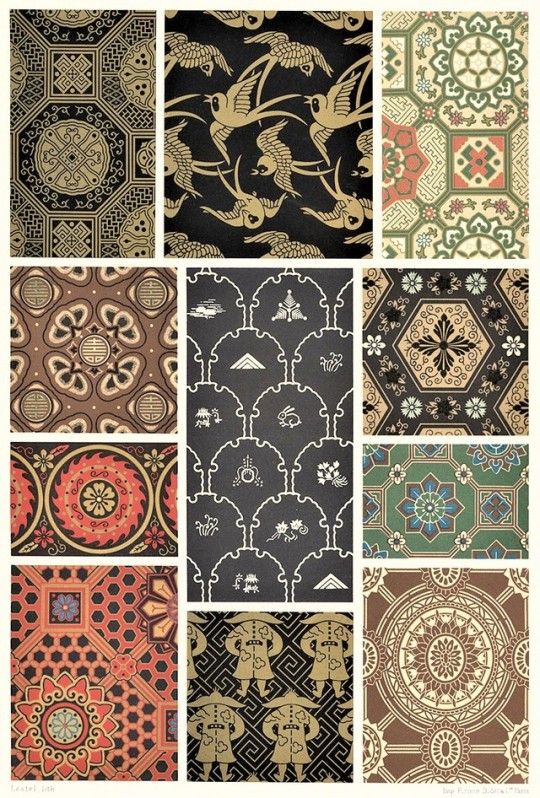


Japanese Decorative Art in Das Polychrome Ornament
Today we are featuring Japanese decorative styles from Das Polychrome Ornament, the German language edition of the second series of L’Ornement Polychrome by French illustrator Albert-Charles-Auguste Racinet (1825-1893), who was an engraver and artistic director at the Parisian publisher Firmin Didot et Cie. The first series of L’Ornement Polychrome was published in ten installments between 1869 and 1873, totaling 100 plates of decorative arts from all over the world, from antiquity through the eighteen century. The second series of 120 plates was published from 1885 to 1887, and it included designs from the nineteenth century. The decorative plates from both series were inspired by various mediums, including textiles, painting, pottery, woodwork, metalwork, and architecture from many different cultures. Das Polychrome Ornament was published in Stuttgart in 1885, and it includes explanatory text in German by Carl Vogel, a professor and architect.
View more posts about decorative arts and pattern books.
–Sarah, Special Collections Graduate Intern
#Das Polychrome Ornament#L’Ornement Polychrome#Albert-Charles-Auguste Racinet#A. Racinet#Albert Racinet#Firmin Didot et Cie.#decorative arts#decorative art#Yay chromoliths!#chromolithographs#chromolithography#Japanese art#Japan#Japanese ornament#ornament#pattern books#Sarah Finn#sarah
108 notes
·
View notes
Photo
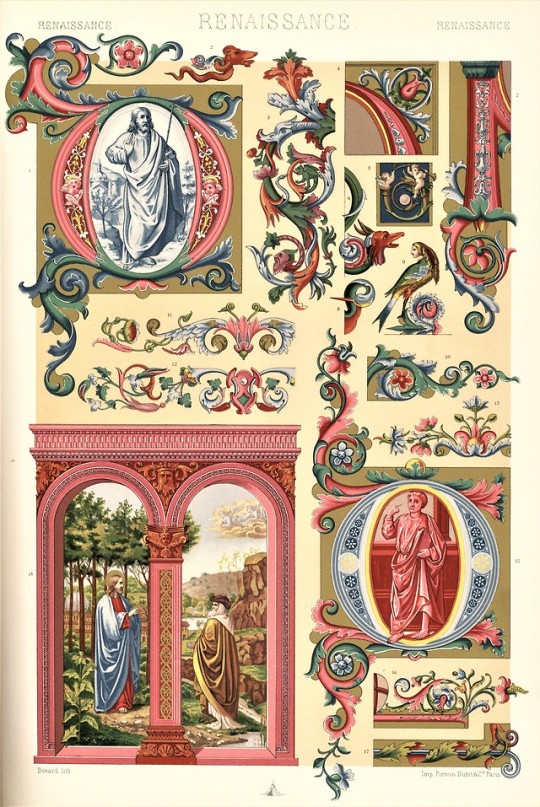

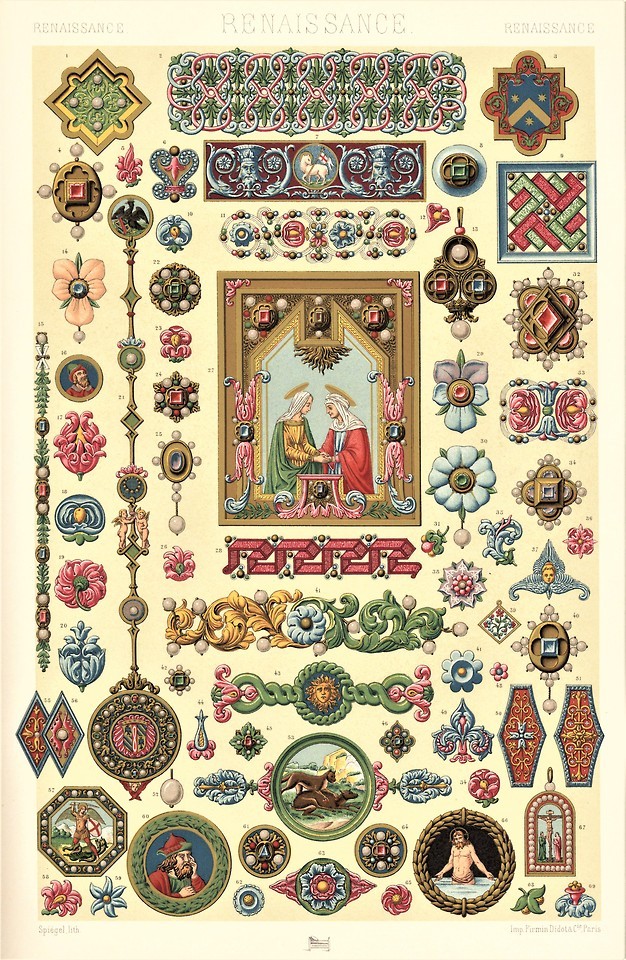


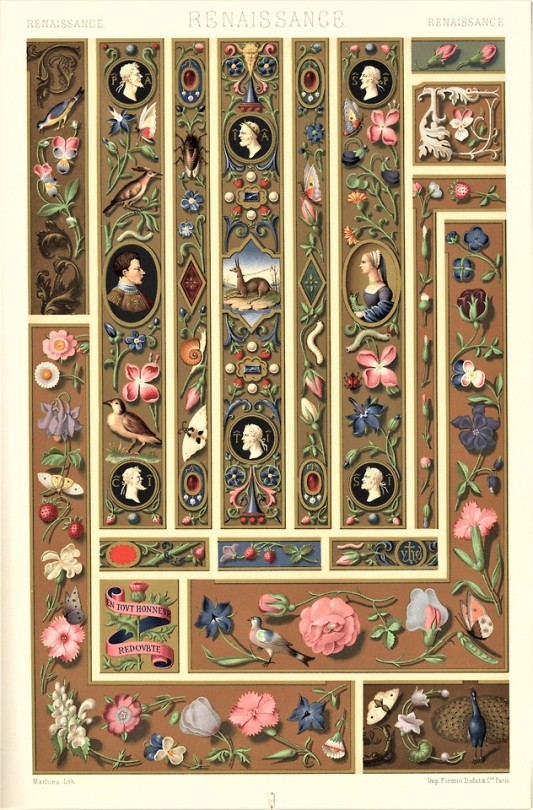
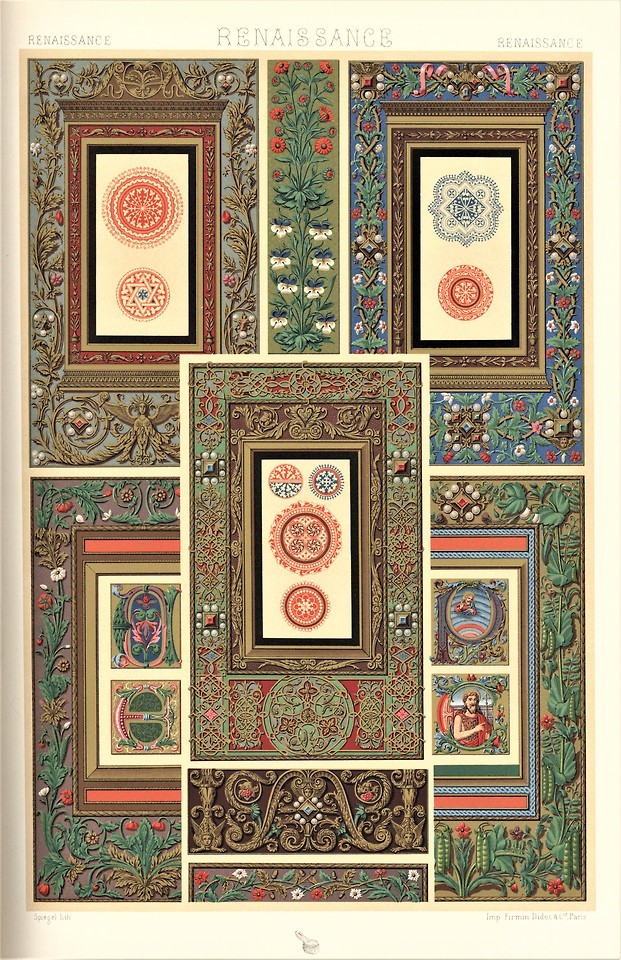
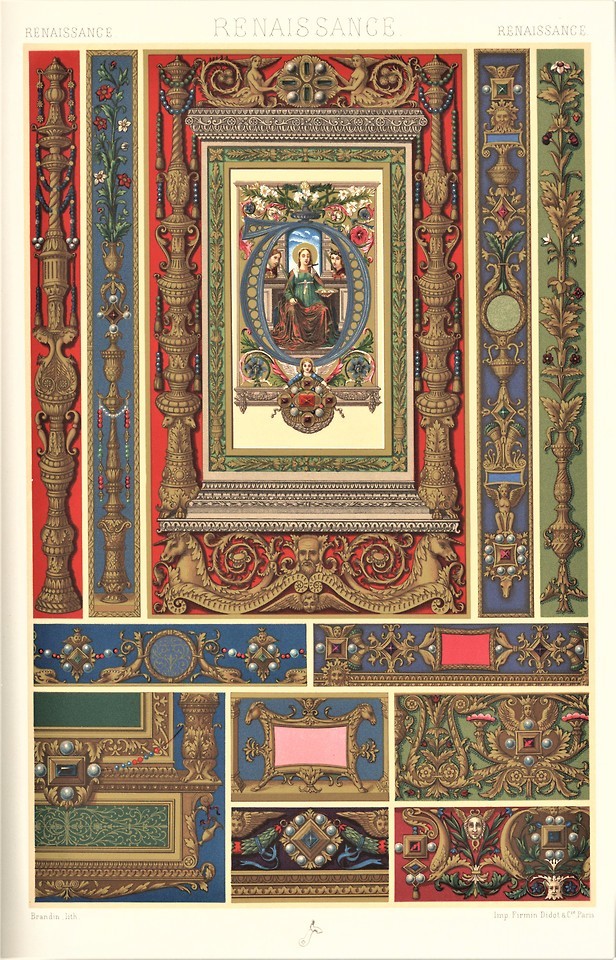
The Renaissance from Das Polychrome Ornament
This week we are featuring Renaissance manuscript and jewelry designs from Das Polychrome Ornament, the German language edition of the second series of L’Ornement Polychrome by French illustrator Albert-Charles-Auguste Racinet (1825-1893), who was an engraver and artistic director at the Parisian publisher Firmin Didot et Cie. The first series of L’Ornement Polychrome was published in ten installments between 1869 and 1873, totaling 100 plates of decorative arts from all over the world, from antiquity through the eighteen century. The second series of 120 plates was published from 1885 to 1887, and it included designs from the nineteenth century. The decorative plates from both series were inspired by various mediums, including textiles, painting, pottery, woodwork, metalwork, and architecture from a many different cultures. The plates were designed by many skilled commercial artists, their names are identified at the lower left hand corner of each plate.
Das Polychrome Ornament was published in Stuttgart in 1885, and it includes explanatory text in German by Carl Vogel, a professor and architect.
–Sarah, Special Collections Graduate Intern
#Das Polychrome Ornament#L’Ornement Polychrome#Albert-Charles-Auguste Racinet#Firmin Didot et Cie#The Renaissance#Renaissance art#Renaissance manuscript#decorative arts#ornament#decorative plates#pattern books#colored plates#chromolithographs#Yay chromoliths!#Sarah Finn#sarah
262 notes
·
View notes